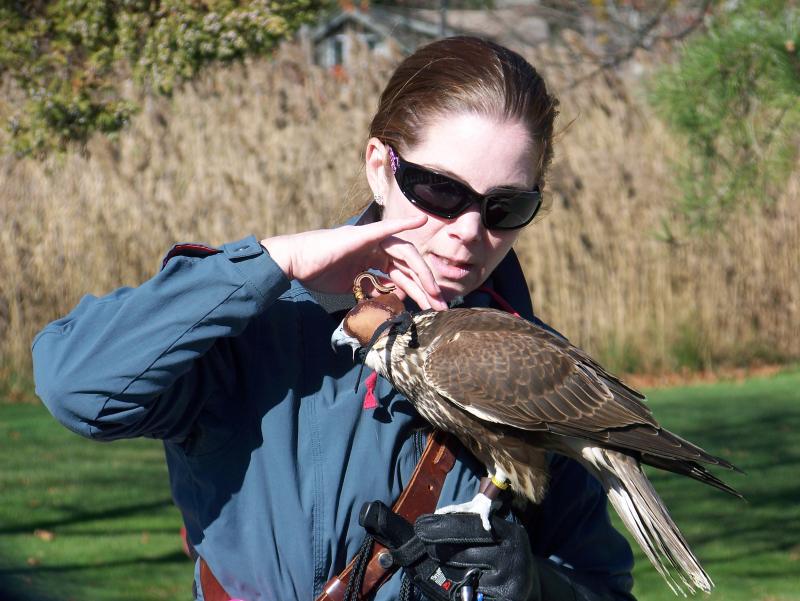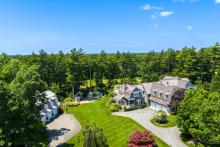Falconry experts talk hawks in Marion
For falconer Diane Welsh, the hardest part of the sport is saying goodbye.
“They never look back,” Welsh said about birds of prey she has trained. “They might hang around my property for a little while because it’s familiar. It reminds me that they are wild animals, but, like a mom, I worry about them.”
On Saturday, Welsh and fellow falconer Michele Losee participated in a “Hawk Walk” hosted by the Sippican Woman’s Club at Silvershell Beach.
Earlier this year, club members read “H is for Hawk”. A memoir by Helen Macdonald, the book chronicles how the author found comfort in the ancient sport following her father’s death.
Falconry, which dates back to 2,000 B.C., is the hunting of wild game with a trained bird of prey.
Intrigued by the sport, the club invited Welsh and Losee to discuss falconry and show off their birds.
A self-described “nature child”, Welsh said she’s always been attracted to the outdoors. Her interest in birds of prey started when her younger sister, a wildlife biologist, would bring injured raptors home before transferring them to a clinic.
“I got to see the birds up close, and I knew I wanted to learn more,” Welsh said.
Not knowing anything about the sport – let alone if anyone in Massachusetts even practiced it – she reached out to the state’s Division of Fisheries and Wildlife 20 years ago for information.
The Burlington resident was given a list of falconers across the state and contacted a few to learn more.
In Massachusetts, prospective falconers must pass a written test, apprentice for two years, and build and maintain all the necessary equipment for falconry to earn a license. They are also subject to inspections from state wildlife officials.
On Saturday, Welsh arrived with her red-tailed hawk, Autumn.
She said that Autumn was captured from the wild before she reached breeding age. Hawks that reach breeding age, usually after turning one, can't be used for falconry.
Welsh explained she had reservations about putting the birds in captivity at first.
“I love these birds so much I wondered if I would be able to take one out of the wild,” she said.
After learning that only 20 percent of juvenile red-tailed hawks survive to adulthood, Welsh decided that she could help the birds by making them better hunters.
Generally, she keeps the birds for one or two years before releasing them back into the wild.
And over time, she’s found each bird to have a different personality.
Autumn is a “sweet, sweet bird” who showed off her wingspan repeatedly to the crowd of 30 people.
“All have their own unique personalities,” she said. “Some are tolerant, others not so much.”
Her first bird taught her not to expect much (if any) affection.
“I loved her and I thought she loved me and then she slammed me in the face,” Welsh said. “That taught me these are always going to be wild animals. They don’t love us like we love them.”
Welsh uses Autumn to hunt squirrels and rabbit for the hawk's meals. The training allows Autumn to become a better hunter without risking starvation if she were on her own.
Welsh said she is equally awestruck watching her birds hunt and seeing their prey outsmart them on occasion.
"It’s a beautiful dance between predator and prey,” Welsh said. “It takes my breath away.”
Losee arrived with her bird, Kublai, a saker falcon native to central Asia. Named for the 13th century Mongol ruler Kublai Khan, Losee said the name felt appropriate.
“He was obsessed with falconry,” she said.
Losee raises, trains and hunts with raptors. They are also a large part of her professional career. She is a raptor ecologist and PhD candidate for environmental studies at Antioch University. Her research is focused on Arizona’s golden eagle population.
While Losee prefers to train eagles, she said there was something about the much smaller Kublai she found irresistible.
“I adore this bird,” Losee said.
Losee and Welsh are part of a growing number of women joining the sport.
Falconry arrived in the United States approximately 100 years ago. In the 1960s, it began to grow in popularity.
Starting out, Welsh said she entered an “old boys network”, but found mentors interested in teaching her. At one bird of prey conference, Losee said she was mistaken for a waitress instead of an attendee.
Joining Losee and Welsh on Saturday were a few apprentices, all women, eager to learn more.
“People I’ve mentored have mentored others,” Welsh said. “I’m a grand-mentor.”



















